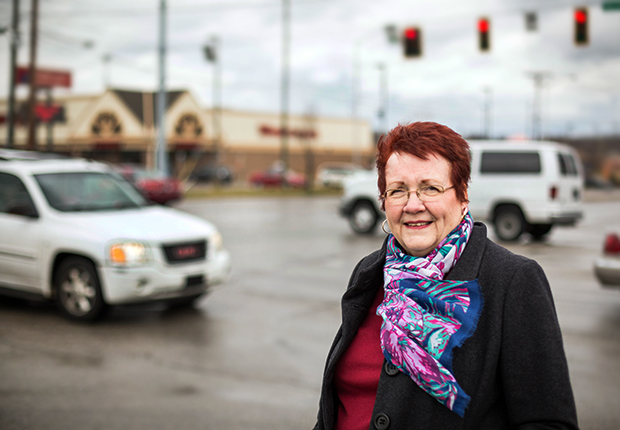AARP Hearing Center

By Bonnie Blackburn
Linda Dunno, of Fort Wayne, saw her son and daughter-in-law struggle to get her grandson’s wheelchair onto sidewalks with narrow curb cuts.
“Just seeing them struggle, trying to get up and down curbs with his little wheelchair” spurred her to action, Dunno said of her grandchild, Cohen Smith, who was born with severe handicaps and died in 2015, at age 5.
Dunno’s 93-year-old father, Vernon Medaugh, who lives near her, would like to be able to walk the quarter mile from his home to a shopping area that includes a post office, restaurants, banks and a movie theater.
These experiences led Dunno, 68, an AARP Indiana volunteer, to urge local government agencies to adopt Complete Streets policies that meet the needs of all people, including pedestrians, bicyclists and those who use wheelchairs or baby strollers.
Roadways designed with the Complete Streets concepts include safe sidewalks, pedestrian crossings, wider curb cuts and traffic signals that allow pedestrians to cross streets safely.
Dunno is part of a coalition involving AARP, Fort Wayne Trails, advocates for people with disabilities and the local chamber of commerce that last year helped push a resolution through the city’s Board of Public Works encouraging the use of Complete Streets principles.
City is eager; cost is a factor
“We hear what people want,” said Fort Wayne City Engineer Shan Gunawardena.
When the city tackles major roadway projects, it tries to incorporate Complete Streets principles, he said. For example, a recent project added sidewalks, landscaping, lighting and timed crosswalks to Maplecrest Road, a major north-south thoroughfare on Fort Wayne’s east side.
Advocates for Complete Streets are also working in other Indiana communities. Kim Irwin is executive director of Health by Design, a statewide partnership with five workgroups, including the Indiana Complete Streets Coalition.
“We help lay the groundwork, coordinate advocacy, develop online petitions and do outreach to neighborhoods” about how the Complete Streets model can be used for road projects.
Active since 2006, the group is starting to see successes, both in Indiana’s larger cities—including Indianapolis and Fort Wayne—and in smaller communities, such as Vincennes, whose Complete Streets policy ranked in the top 10 nationally in 2015, according to the advocacy organization Smart Growth America.
By making their voices heard, advocates have been able to get cities to incorporate many improvements where sidewalks either had been missing or were not safe.
Cost is the biggest roadblock to making improvements, Gunawardena said. It can cost millions of dollars to redo city streets, and Fort Wayne has more than 1,200 miles of paved streets to maintain. As Fort Wayne has grown, it has annexed county roads that never had sidewalks, and the city can’t get the rights-of-way to add them.
“Our response is that you can’t afford not to,” Irwin said. “When they don’t think about everyone, they do not spend those improvement dollars wisely.”
That said, in the past 10 years the city has added 38 miles of sidewalks to its 1,600 existing miles, plus 40 miles of new trails, bringing that total to 100 miles, according to Gunawardena.
As for Dunno’s father, Vernon Medaugh, he lives just east of that same Maplecrest Road that was redesigned to include Complete Streets principles. The city will be upgrading his stretch to include pedestrian-friendly sidewalks beginning in 2018.
Bonnie Blackburn is a writer living in Fort Wayne, Ind.































































